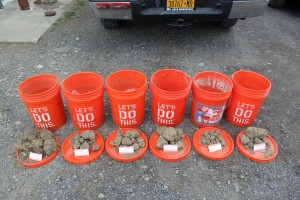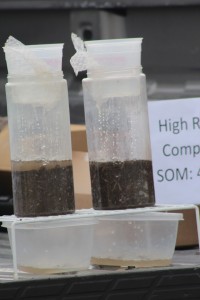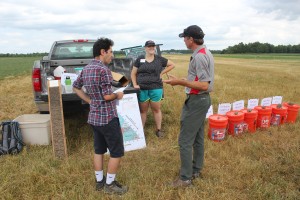 A big part of what our NMSP team does is extension work. We conduct a lot studies, but none of it will ever be significant if we cannot effectively communicate the things we learn with farmers to improve NY s agriculture. Most of our research plots are located in Aurora, NY at Musgrave Research Farm. To better present our findings to farmers and farm advisors, the farm hosts an annual field day where various groups may create short 20-25 minute presentations. Because I am working on the Dairy Cap project (currently in its 16th year here at Cornell) our presentation was titled “Tracking Soil Changes from Long-Term Manure Applications”. We talked to the farmers, farm advisors, and other extension agents who attended primarily about changes over time in corn and hay yields as well as soil organic matter trends.
A big part of what our NMSP team does is extension work. We conduct a lot studies, but none of it will ever be significant if we cannot effectively communicate the things we learn with farmers to improve NY s agriculture. Most of our research plots are located in Aurora, NY at Musgrave Research Farm. To better present our findings to farmers and farm advisors, the farm hosts an annual field day where various groups may create short 20-25 minute presentations. Because I am working on the Dairy Cap project (currently in its 16th year here at Cornell) our presentation was titled “Tracking Soil Changes from Long-Term Manure Applications”. We talked to the farmers, farm advisors, and other extension agents who attended primarily about changes over time in corn and hay yields as well as soil organic matter trends.
I worked with Amir Sadeghpour, the post-doc whom I’ve been working with on the Dairy Cap project, as well as Karl Czymmek, PRO-DAIRY senior extension associate. Amir and Karl have much more experience with the project and so they took the lead on discussing the data and long term trends, while I focused on a visual to show the audience that the changes go beyond numbers on paper. We also teamed up with Amy Langner, a NRCS agent, who was able to show us how to demonstrate a rain infiltration test. Amy was super helpful, extremely enthusiastic, and encouraged me every step of the way!

display of soil clods from various treatments, notice the difference between continuous grass clods (far left) and 0N clods (second to last bucket lid)
I presented the crowd with a display of soil clods from soils treated with inorganic and organic fertility amendments (0 inputs, inorganic 150 lb/ acre N, high rate of compost, high rate of manure, low rate of manure, and continuous grass) as well as with the infiltration test demonstrating the lack of aggregate stability in the 150 lb/ acre soil leading to surface crusting as compared to the soil that received high rates of compost which, generally, has shown us better infiltration with its increased aggregate stability.

mock rain/infiltration demonstration, soil from inorganic (left) vs organic (right) fertility treatments after being “rained on”
Luckily, the infiltration demo worked spectacularly for the first crowd! The differences were very apparent and it really sparked the audience’s attention. The second demo did not show clear differences between the two, which was disappointing, but it definitely helped us to practice thinking on the spot as we continued to defend our findings, even when the demo wasn’t cooperating.
Overall, we had a really fun day connecting with new people and spending time together outside of the office. It was a really great opportunity to practice my extension skills and share our enthusiasm about soil with the audience!

